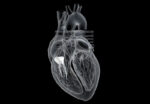Original title: Endothelial cell repopulation after stenting determines in-stent neointima formation: effects of bare-metal vs. drug-eluting stents and genetic endothelial cell modification. Reference: Douglas G et al. European Heart Journal doi:10.1093/eurheartj/ehs240 Experimental models of vascular injury have shown that the rate of endothelial cell repopulation post-injury is a critical factor in determining subsequent neointima formation as well as...
Stent MGuard, primary angioplasty with a higher TIMI III
Original title: The MASTER Trial – Prospective, Randomized, Multicenter Evaluation of a Polyethylene Terephthalate Micronet Mesh–Covered Stent (MGuard) in ST-Segment Elevation Myocardial Infarction. Reference: Gregg W. Stone et. al. J Am Coll Cardiol 2012; 60: 1975-1984 Primary angioplasty has proven effective in restoring epicardial flow but myocardial perfusion is often suboptimal. One of the main mechanisms is distal...
Plug versus coils for embolization of the internal iliac artery stent implantation.
Original title: Comparison of outcomes with coils versus vascular plug embolization of the internal iliac artery for endovascular aortoiliac aneurysm repair. Reference: Evan J. Ryer et al. J Vasc Surg 2012;56:1239-45 20% of patients with abdominal aortic aneurysm (AAA) present a compromise of the common distal iliac artery, these often require the stent to cover up to the...
A new paradigm in the treatment of in-stent restenosis?
Original title: ISAR DESIRE 3: Drug-eluting balloon is best option for restenosis of limus-eluting stents Reference: Dr Robert Byrne. TCT 2012. Miami, Fl. The first of the ISAR DESIRE trials showed that drug-eluting stents (DES) were the best strategy for treating restenosis of a bare metal stent, the second ISAR DESIRE trial tested the hypothesis of changing or...
Drug eluting balloon; a valid alternative to treat in-stent restenosis in the superficial femoral artery
Original title: Drug-Eluting Balloon for Treatment of Superficial Femoral Artery In-Stent Restenosis Reference: Eugenio Stabile et al. Journal of the American College of Cardiology 60:1739–42 (2012) Drug eluting balloon; a valid alternative to treat in-stent restenosis in the superficial femoral artery This prospective registry included 39 patients who received Paclitaxel-Eluting Balloon Angioplasty, (IN.PACT, Medtronic, Minneapolis, Minnesota), for in-stent...
Future second-generation stents, today.
Original title: First Serial Assessment at 6 Months and 2 Years of the Second Generation of Absorb Everolimus-Eluting Bioresorbable Vascular Scaffold A Multi-Imaging Modality Study. Reference: John Ormiston et al. Circ Cardiovasc Interv. 2012;5:620-632. The first bioabsorbable stents eluting everolimus showed a 6-month delayed recoil resulting in late lumen loss of 0.44 mm, (intermediate between a metal stent...
Drug-Eluting Stents: device without polymers overcomes limitations of first generations stents
The NEXT randomized trial showed the superiority of a polymer-free amphilimus-eluting stent compared to paclitaxel-eluting stents with permanent polymers The NEXT clinical trial (International Randomized Comparison Between DES Limus Carbostent and Taxus Drug-Eluting Stents in the Treatment of De Novo Coronary Lesions), is a multicenter randomized trial (n=296) comparing coronary amphilimus eluting stent Cre8 (CID,...
Cardioband in Tricuspid Valve Regurgitation
Untreated tricuspid regurgitation (TR) has been associated to high morbimortality. Surgical treatment of isolated severe TR is complex and carries a high mortality rate. A transcatheter treatment of this valve is currently being developed, and different concepts are being applied to the new devices. Even though most TR is secondary, atrial functional tricuspid regurgitation (A-FTR)...
QFR Analysis of Coronary Lesions with TAVR
While transcatheter aortic valve replacement (TAVR) has shown benefits, significant coronary artery disease affects 50% or more of patients who undergo such procedure. However, it is still unclear which is the best treatment strategy or how to handle this condition. Quantitative flow ratio (QFR) could be a non-invasive option to assess the severity of coronary...
Events in CAD Patients Who Refused or Were Ineligible for CABG
When deciding on the optimal coronary artery revascularization treatment of coronary artery disease (CAD) patients, physicians normally assessed clinical presentation, surgical risk, survival expectation, and the likelihood of a better quality of life. Decisions are made after careful consideration, by the Heart Team, who will ponder options such as coronary artery bypass graft (CABG), percutaneous...



